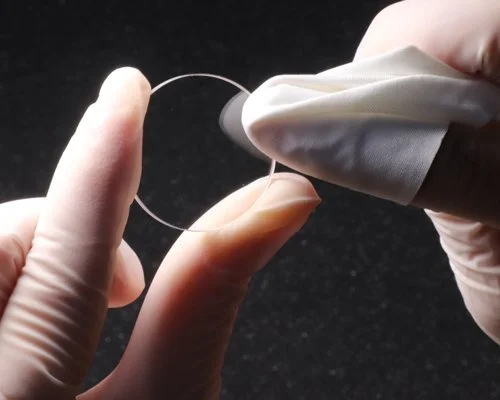Optical Windows
Optical windows are transparent components made of materials like glass or crystal that are used to protect and control the flow of light in optical systems. IR windows and optics for use in FTIR Spectroscopy and CO2 lasers. This includes discs, rectangular plates and various other geometries.
In various fields, optical windows serve many purposes. They act as protective barriers, shielding sensitive optical components from environmental factors such as dust, moisture, and contaminants. Additionally, they enable the transmission of light while minimizing distortion, reflection, and absorption, thus maintaining the integrity of the optical system.
Optical windows are employed in a wide range of applications, including scientific research, industrial manufacturing, aerospace, defense, and telecommunications. They are utilized in optical instruments like cameras, microscopes, telescopes, lasers, and sensors. By providing a stable optical interface, optical windows facilitate accurate measurements, imaging, and analysis of light, enabling advancements in numerous fields.
Optical windows come in many shapes and sizes but a major factor is their material. The types of materials that an optical window is constructed from dictate the wavelengths (measured in nm) that they can view. In IR It is extremely important that selecting the right material is done to avoid many a headache and a waste of money and time.
If you are having choice fatigue and are getting overwhelmed by all the options please check out our optical window guide.
Calcium Fluoride (CaF2) Windows
Calcium Fluoride (CaF2) Windows
Calcium Flouride or CaF2 is a versatile optical material that can be used from deep in the UV range to far out into the long wavelength infrared range (130nm-10µm). With a low absorption coefficient and a high damage threshold, CaF2 is a common choice in laser and cryogenic applications as well as spectroscopy or fluorescence imaging in the UV, VIS and IR wavelengths.
The low index of refraction enables this material to be used without AR coating, making it a versatile, cost-effective option.
Firebird provides these in several uncoated stock configurations but can provide customized and coated to your specifications.
Calcium Fluoride (CaF2) Basics:
Calcium Fluoride (CaF2) is a material that has been widely used in the field of optics due to its unique optical properties. One of the key applications of Calcium Fluoride is in the manufacture of optical windows. These windows are transparent to ultraviolet, visible, and near-infrared light, making them ideal for use in a variety of optical systems.
Calcium Fluoride has a high transmission range, which makes it ideal for use in a variety of applications that require a broad spectral transmission range. It is commonly used in applications where high transmission and low absorption are required, such as in spectroscopy, laser systems, and imaging systems.
One of the biggest advantages of Calcium Fluoride windows is their ability to transmit ultraviolet light, which is not possible with traditional glass windows. This makes them ideal for use in applications where ultraviolet light needs to be transmitted, such as in UV spectroscopy and UV imaging.
Calcium Fluoride windows are highly durable and can withstand harsh environmental conditions, making them ideal for use in industrial and scientific applications. They are also highly resistant to thermal shock, making them ideal for use in high-temperature applications.
The production process of Calcium Fluoride windows requires special equipment and techniques to ensure that the windows are of high quality and have the correct optical properties. The windows can be manufactured using a variety of techniques, including polishing, diamond turning, and grinding.
Calcium Fluoride windows are essential components in a variety of optical systems, offering a range of benefits over traditional materials such as glass. Their high transmission range, durability, and resistance to thermal shock make them ideal for use in a variety of applications, including spectroscopy, laser systems, and imaging systems. As the demand for high-quality optical components continues to grow, Calcium Fluoride windows will continue to play a critical role in the development of new optical systems.
Material Characteristics:
Calcium Fluoride (CaF2) is a material with the following specifications:
Chemical Composition: Calcium Fluoride is a binary compound composed of calcium (Ca) and fluorine (F2) with the chemical formula CaF2.
Optical Properties: CaF2 has a high refractive index and a low absorption coefficient, making it ideal for use in optical systems. It has a high transmission range, transmitting ultraviolet, visible, and near-infrared light.
Physical Properties: CaF2 is a crystalline material with a cubic crystal structure. It has a high hardness and is highly resistant to thermal shock. The material has a high thermal expansion coefficient, which must be taken into consideration when designing optical systems.
Melting Point: The melting point of CaF2 is 1412°C.
Density: The density of CaF2 is 3.18 g/cm3.
Optical Bandgap: The optical bandgap of CaF2 is 10.6 eV.
Dispersion: The material has a low dispersion, making it ideal for use in imaging systems.
Surface Finish: The surface finish of CaF2 windows can be polished, diamond turned, or ground, depending on the specific requirements of the application.
Calcium Fluoride is a material with unique optical and physical properties that make it ideal for use in a variety of optical systems. Its high transmission range, low absorption coefficient, and high refractive index make it a popular choice for applications in spectroscopy, laser systems, and imaging systems.
Benefits of Calcium Fluoride (CaF2) Windows:
High Transmission Range: CaF2 windows have a high transmission range, making them ideal for use in applications that require broad spectral transmission, such as spectroscopy and laser systems.
Transmits UV Light: CaF2 windows are transparent to ultraviolet light, which is not possible with traditional glass windows, making them ideal for use in UV spectroscopy and imaging applications.
Durability: CaF2 windows are highly durable and can withstand harsh environmental conditions, making them ideal for use in industrial and scientific applications.
Thermal Stability: CaF2 windows are highly resistant to thermal shock, making them ideal for use in high-temperature applications.
High Refractive Index: CaF2 has a high refractive index, making it ideal for use in high-resolution imaging systems.
Drawbacks of Calcium Fluoride (CaF2) Windows:
Cost: CaF2 windows can be more expensive than traditional optical glass or fused silica windows due to the special equipment and techniques required to manufacture them.
Scratch sensitivity: CaF2 windows are more susceptible to scratches and other surface damage compared to traditional glass or quartz windows.
Absorption: CaF2 windows have a high absorption rate, making them unsuitable for applications where low absorption is required.
Manufacturing Complexity: The production process of CaF2 windows requires special equipment and techniques, making them more difficult to manufacture compared to traditional glass or quartz windows.
Calcium Fluoride (CaF2) windows offer several advantages over traditional glass or quartz windows, including high transmission range, durability, and thermal stability. However, they also have some disadvantages, such as cost, scratch sensitivity, and high absorption rate. The choice of whether to use CaF2 windows or not will depend on the specific requirements of the application and the trade-off between the advantages and disadvantages.
CaF2 Specs:
| Wavelength range: 130nm-9.5µm | Coating: Uncoated |
|---|---|
| Diameter tolerance: ±0.1mm | Surface Quality: 60/40 |
| Thickness tolerance: ±0.2mm | Paralellism: <1 arc minute |
| Clear Aperture: 90% | Density: 3.18g/cm3 | Melting point: 1360ºC | Young's Modulus: (GPa): 75.8 | Coefficient of Thermal Expansion: 18.85 x 10-6/°C | Knoop Hardness: 158.3kg/mm2 |









Finding the right optical window can be an exercise in choice fatigue. Let us help!